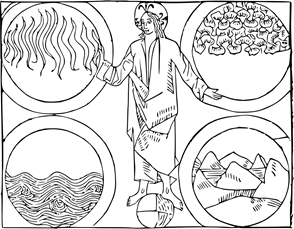The Folklore Of Cryptocurrencies: Alchemy Revisited?
Wednesday, 01 November 2017By Bob McDowall
(Or, How Myths and Legends Can Grow in Under 10 Years)
Introduction
Cryptocurrencies are a recent global financial and technological phenomenon, one that has emerged in the last 10 years. Yet the folklore of cryptocurrencies has grown as quickly as the origination and dissemination of the number of currencies themselves. Folklore is no longer circumscribed as being chronologically old or obsolete. Those, who study folklore, analyse and evaluate “the traditional artefacts of a social group and how they are transmitted”.
The myths and legends around the development and use of crypto-currencies have grown as quickly as their adoption. The myths and legends have added to the mystique or even magical properties of what, under the laws of most jurisdictions, are no more than tokens which are accepted by some communities within the jurisdiction as a means of storing and exchanging value.
What are Cryptocurrencies and How Do They Work?

Before observing some of the myths and legends surrounding crypto currencies, it be helpful to explain in more detail the principles and operational workings of crypto- currencies. A cryptocurrency is a digital asset, that is an asset stored electronically, designed to work as a medium of exchange using cryptography to secure the transactions and to control the creation of additional units of “the currency”. Crypto currencies are decentralised. Decentralised crypto currency is produced by the entire crypto currency system collectively. The rate of production is defined and publicised when the system is created. By contrast centralized banking and economic systems such as the UK through the Bank of England or in the USA through the Federal Reserve, other sovereign jurisdiction boards or governments, control the supply of currency by printing units of “fiat money” or demanding additions to digital banking ledgers. In case of decentralized crypto currency, companies or governments cannot produce new units. To date they not provided backing for other firms, banks or corporate entities, which hold assets valued measured in it. The underlying technical system, upon which decentralized crypto currencies are based, was created by the group or individual known as ”Satoshi Sakamoto” of Bitcoin fame.

Over a thousand crypto currency specifications exist. Most of them have similar characteristics to the first fully implemented decentralised crypto currency, “Bitcoin.” Within crypto currency systems the financial integrity and balance of its records (“ledger”) is maintained by a community of mutually distrustful parties, affectionately termed “miners.” Holders and users of crypto currencies use their computers to help validate and timestamp transactions, which they adding to the ledger in accordance with a particular time stamping scheme. Miners have a financial incentive to maintain the security of a crypto currency ledger.
Most crypto currencies are designed to gradually decrease production of currency. They place an ultimate cap on the total amount of currency that will ever be in circulation, mimicking precious metals. Compared with fiat currencies held by financial institutions or kept as cash on hand, crypto currencies can be more difficult for seizure by law enforcement authorities. This difficulty is derived from using cryptographic technologies.
Why Has the Folklore of Cryptocurrencies Developed So Quickly?
Many themes which resonate in Folklore are present in the development of cryptocurrencies:
- The Mystery Surrounding the Source or Inventor
The creator of the first cryptocurrency is known as “Satoshi Sakamoto.” The real identity or identities remains a mystery. Whether the inventor was Japanese as the name suggests or not is again remains unverified. Such behaviour is unusual in contemporary business world where people like to stake their claim to successful inventions. Sightings have been made allegedly of the inventors. The shadows hide the identity of the inventor and contribute to the mystique and mystery of the invention.

- Ex Nihlo Nihil Fit
This expression from classical philosophy describes the concept that substance and value has to be derived from material. Cryptocurrencies are derived from the production of a cryptographic formula. The first principles of Nature are that “nothing is brought forth by any supernatural power out of naught” according to the Roman Philosopher, Lucretius, who proceeded to state that:
”For if things are created out of nothing, any breed
Could be born from any other; nothing would require seed.”
The creation of crypto currencies add to their mystique because they not a form of natural creation. - Parallels With Alchemy
Alchemy was an ancient practice which sought to turn base metals into gold by transforming the material characteristics of base metal into something of value. The ancient practice was seen as a cross between scientific study and charlatanism. Practitioners conducted their experiments in secret and maintained records of their experimental work in cyphers and cryptic symbolism. Legislative prohibition accompanied by criminal sanctions and disapproval by Christian Churches contributed to the aura of secrecy and shadowy practices. While miners of crypto currency do not practice in shady places, the security, energy and cryptography used in creation of crypto currencies do borrow from the science of Alchemy.

- The Symbolism of Tokens in Folklore
Crypto currencies are “electronic tokens” are classified as such currently by most legal jurisdictions. Like many tokens in folklore, crypto currencies can bring luck, fame and fortune through the value they are perceived to bring to the owner. Tokens are symbols. Symbols can bring good luck. They are designed to enhance the holder's mind-set. In turn they produce enhanced life experiences. Good luck symbols for business are a subtle way to bring attention back into focus. Contemplating the symbolic meaning of an object that traditionally represents good luck is one way to help focus on the glittering prize.
The Chinese have a custom of giving red envelopes of money (Hung Bao), during the Chinese New Year and at weddings. Symbols of wealth and luck usually decorate the outside of the red money packages. Red envelopes are used for Chinese lucky money as the Chinese consider red the colour of luck and happiness. Red envelopes sold for the use of Hung Bao have Chinese symbols of luck and happiness on the outside. These envelopes are very elegant and fancy with embossed gold designs on a rich red background. Hung Bao given in red envelopes is considered to work against evil. - The Role of Communities
Folklore is a vibrant element of life and behaviour as well as cultural heritage. Beliefs, customs and expressions link the past to the present and help the understanding of our specific communities and cultures, as well as our shared humanity. Far from being static or an ageing genre, it remains relevant by adapting to new circumstances, with the 'Folk' (people), and the 'lore' (stories) continually informing and influencing each other. Cryptocurrencies bring together communities of interest. Principally the communities share value in the form of the means of exchange within a closed group of people anonymously in most instances. Some of those communities share social and economic values in their attitude to “fiat money.” - The Velocity of Communication Through Social Media
Technological communication is transforming folklore. The myths and mysteries of crypto currencies have spread very rapidly through technological communication rather than word of mouth or the traditional written word. Communication of the technical and business developments of crypto currencies has been disseminated through social media. Social media has hastened the velocity and diversity of the communication of news over the past decade. Some of the news has been described as “fake news” or “fake information”, which embellishes and colours basic dissemination of facts, as happens when people relate their experiences.

- The Folklore of Value
When commodities such as salt or grain were used as currency, they had an intrinsic value. When people traded with others, they retained the option to store it or consume it. Gold and silver had an ornamental value that gave them an intrinsic value beyond their use as a medium of exchange. Paper money was the first instance of currency having no intrinsic value beyond the trust and belief others invested in it. While cryptocurrencies are as reliant on trust as paper money to be used as a medium of exchange but that distrust is fuelled by the mistrust in national governments.
Cryptocurrencies are built on the concept of trust while reducing the risk that the value will go down because a national government will print too much paper money; devalue the currency through a single shift in the official exchange rate. Equally, national governments can demand “haircut” of everyone’s bank accounts to reduce what is in circulation while generating a one-time influx of state revenue.
This article is part of Robert McDowall's series of articles on Folklore & Finance.
Bob McDowall is a former President of the Folklore Society and is also engaged in the research and analysis of cryptocurrencies and the technology which supports their operation.